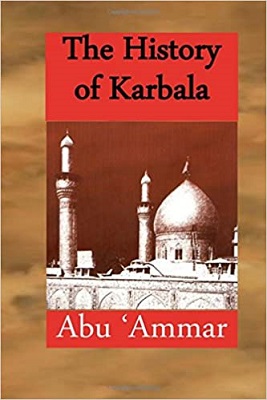The History of Karbala
 | |
| Author | Abu Ammar |
|---|---|
| Language | English |
| Published | 2014 |
| Publisher | Brawtley Press |
| Pages | 90 |
The book The History of Karbala presents authentic narrations regarding the events of Karbala.
About the book[edit | edit source]
This book published by Brawtley Press (September 26, 2014), has 90 pages.
This booklet tries to show Imam Husain’s excellence, his bravery and the sacrifices that he made, and to refute the objections that have been made against him.
Abstract of chapters[edit | edit source]
Part I, THE BACKGROUND OF KARBALA[edit | edit source]
At the beginning of the book, the author gives a brief biography of Imam Husain, (Imam Husain was born to the daughter of the Prophet, Sayyida Fatima, in the month of Shaban 4 Hijra). After the death of Mu'awiya, Yazid bin Mu’awiyah, became the ruler of the Muslims. Most of the people had pledged their allegiance to him. However, three of the companions of the Prophet in Madina had not done so, (Imam Husain, Abdullah bin Zubair, and Abdullah bin Umar). Imam Husain was asked to swear allegiance to Yazid, but he didn’t accept. He gathered all his family members and his friends and followers who were going with him and left for Mecca from Madinah at the invitation of the people of Kufa. The governor of Makkah, Amir bin Sa'id, tried to stop them as he thought that Imam Husain would take over Kufa and overthrow the governor there, but eventually Imam Husain and his supporters were able to defeated them and continued with their journey. Along the route some travelers pleaded Imam Husain not to undertake this journey as no reliance could be placed upon the promises made by the Kufans. Finally, the same thing happened.
Part II, KARBALA[edit | edit source]
Imam Husain continued with the journey and eventually on 2nd Muharram 61 Hijra they reached Karbala. Umar bin Sa`d who was the son of one of the companions of the Prophet, on 7th of Muharram was given orders to go to the river, where Imam Husain was stationed, and stop him and his people from obtaining any water from it. Imam Husain’s brother Sayyiduna Abbas, asked the reason of enemies’ coming there, then Imam Husain told Sayyiduna Abbas to tell Umar to give them until that night to make Dua (supplication), recite the Qur'an and perform Salah (prayers). After that Imam Husain gathered all his people together and said:
You have been very loyal to me; you have stayed with me through good and bad. I am happy with you all and I willingly give you my permission to go back to Makkah.
Then Imam Husain recited some sad poetry. His sister Zaineb heard him and cried out. So, Imam Husain comforted to his sister. After that, when Imam Husain saw that both sides were ready to go to war, he mounted a camel and faced the opposition and made a historical sermon. The good thing here was that when Umar bin Sa’d decided to attack, Hur joined Imam Husain and left Umar bin Sa’d‘s army. It was on 10th of Muharram Umar bin Sa’d got his bow and arrows ready and started to fire them towards Imam Husain and his followers and the war began. The loyal followers of Imam Husain martyred in turn like Habib bin Mazhar and Hur bin Yazid. After that Imam Hossein's family martyred until Imam Hossein remained alone. Finally, it was during Friday prayer on the 10th of Muharram in 61 Hijrah that Imam Husain was martyred.
Part III, EVENTS AFTER MARTYRDOM[edit | edit source]
In this part the author has listed the evens that were happened after the martyrdom of Imam Husain for his family. Then he has provided a list of the names of people who were martyred in Karbala. At the end of the book, he examines two wars, one between the people of Medina and Syria Army, and the other between the people of Mecca and Syria Army.